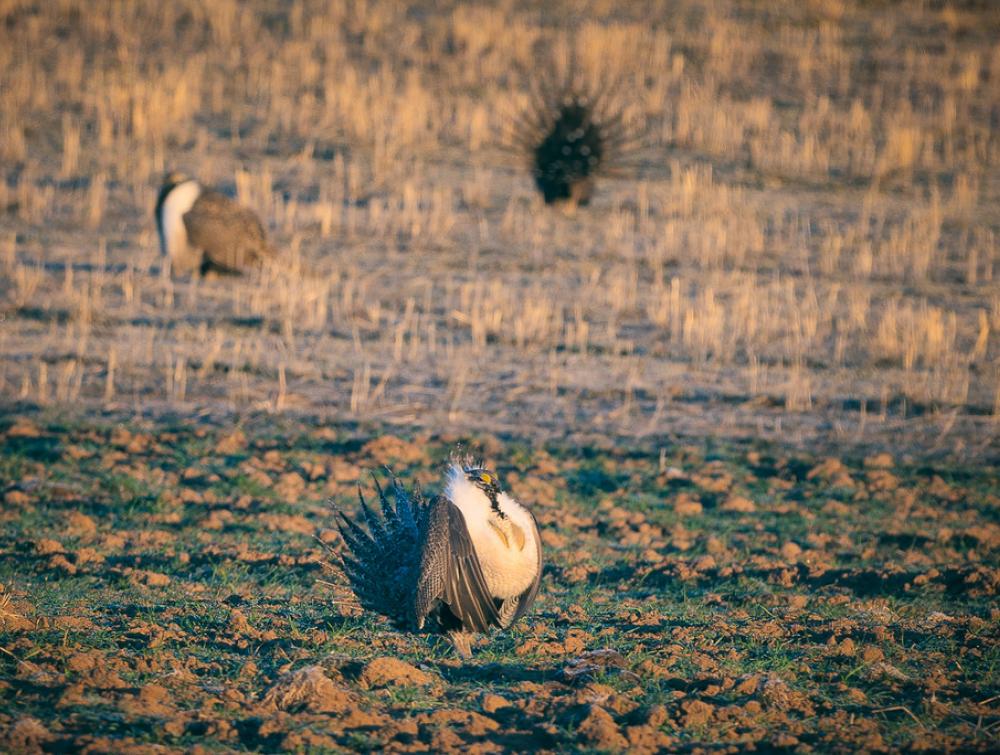New maps show Interior Department overtaking sage-grouse habitat with oil and gas leasing sales

Mason Cummings, The Wilderness Society
76 percent of upcoming oil and gas lease sales occurs inside protected greater sage-grouse habitat out West
Protections safeguarding the greater sage-grouse habitat across the western United States are still currently in place, and yet 76 percent of the Bureau of Land Management’s upcoming and newly offered oil and gas leasing on public lands occurs inside protected habitat across Colorado, Nevada, Utah, and Wyoming, according to new mapping.
The map and accompanying data table use information from the BLM’s lease sale page and the agency’s Landscape Approach Data Portal to show leasing in grouse habitat by state, including calculations about how much of each sale is in habitat. Notably, the 2015 sage-grouse plans incorporate varying level of protections for all sage-grouse habitat and tell BLM to prioritize leasing outside of habitat.
According to the new mapping, 50.8 percent of oil and gas leases offered in last week’s sales in Colorado intersects with sage-grouse habitat on public lands in the state. And in Wyoming, nearly all – 99.9 percent – of 1.3 million acres being offered for oil and gas leases in upcoming sales in Wyoming intersects with sage-grouse habitat on public lands in the state. In Utah, 47.9 percent of the leases offered are in existing sage-grouse habitat and 10.3 percent of the leases that will be offered in an upcoming sale intersect with the bird’s habitat.
At last week’s Colorado sale, BLM sold 5,500 lease acres in North Park sage-grouse habitat, an area known as a “sportsmen’s paradise” because of big game herds that continue to thrive due to the lack of intensive development. North Park is also one of the “strongholds” for grouse areas, where sage-grouse continue to prosper, and current protection efforts should be prioritized.
“Ironically these are precisely the sorts of places where leasing should be minimized, because of the importance of grouse as well as big game habitat and because many of the leases have low development potential. Unfortunately, this sale is indicative of the Trump Administration’s approach to managing leasing in sage-grouse habitat across the west. Instead of prioritizing leasing outside of grouse habitat, which so often provides good quality habitat for big game, the administration is blindly offering as many leases as it can,” said Barbara Vasquez, a resident of Jackson County and former member of BLM’s Northwest Colorado Resource Advisory Council.
Existing and future leases also threaten Moffat County, bordering Wyoming and Utah in the northwest corner of the state.
“For wildlife, Moffat County is just a quiet bay in Wyoming’s larger sagebrush sea. We are home to 70% of Colorado’s Greater sage grouse population as well as its largest elk, mule deer and pronghorn herds. The area boasts high quality sagebrush habitat, which not only supports sage grouse, but also provides critical winter range for those big game species. In turn, hunting is a significant and sustainable economic driver for our local community. However, this symbiotic relationship is threatened by the Department of Interior’s failure to prioritize leasing outside of priority and general habitat and threatens to curtail sage grouse recovery efforts, ultimately placing us at a greater risk of a future ESA listing,” said Luke Schafer, West Slope director at Conservation Colorado.
While the leasing violates the spirit and the letter of the current federal plans, the proposed leasing will also hamstring the states’ ability to provide input into the ongoing planning process, even though the Interior Department has said the reason it is overhauling the landmark conservation plans is to give states more of a say. Leasing the federal lands will also increase the burden on states to protect habitat on state and private lands.
Contacts
Alex Thompson, The Wilderness Society, alex_thompson@tws.org, 202-429-3940
Judith Kohler, National Wildlife Federation, kohlerj@nwf.org, 720-315-0855
Nicolas Gonzalez, National Audubon Society, ngonzalez@audubon.org, 212-979-3068
The Wilderness Society, founded in 1935, is the leading conservation organization working to protect wilderness and inspire Americans to care for our wild places. With more than one million members and supporters, The Wilderness Society has led the effort to permanently protect 109 million acres of wilderness and to ensure sound management of our shared national lands. www.wilderness.org
